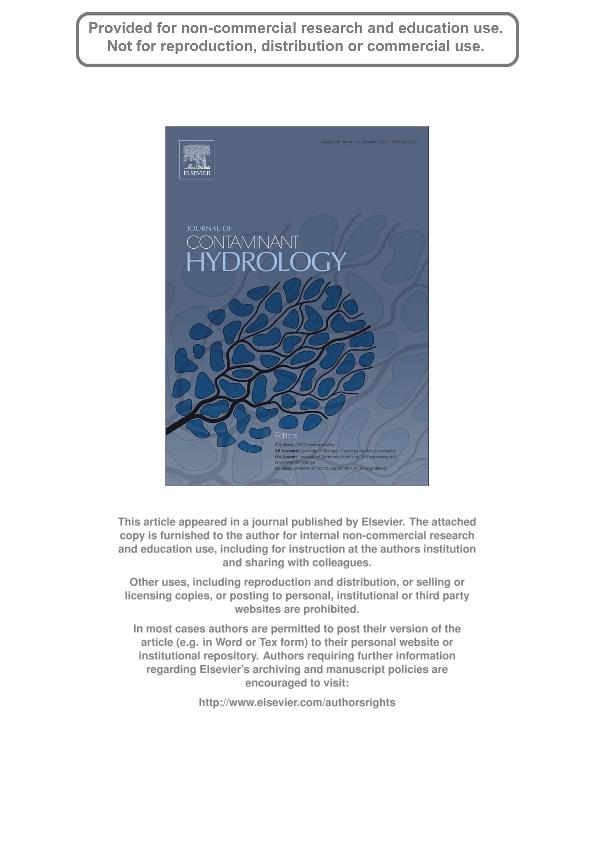Artículo
Identifying key controls on the behaviour of an acidic-U(VI) plume in the Savannah River Site using reactive transport modeling
Bea, Sergio Andrés ; Wainwright, Haruko; Spycher, Nicolas; Faybishenko, Boris; Hubbard, Susan S.; Denham, Miles E.
; Wainwright, Haruko; Spycher, Nicolas; Faybishenko, Boris; Hubbard, Susan S.; Denham, Miles E.
 ; Wainwright, Haruko; Spycher, Nicolas; Faybishenko, Boris; Hubbard, Susan S.; Denham, Miles E.
; Wainwright, Haruko; Spycher, Nicolas; Faybishenko, Boris; Hubbard, Susan S.; Denham, Miles E.
Fecha de publicación:
08/2013
Editorial:
Elsevier Science
Revista:
Journal of Contaminant Hydrology
ISSN:
0169-7722
Idioma:
Inglés
Tipo de recurso:
Artículo publicado
Clasificación temática:
Resumen
Acidic low-level waste radioactive waste solutions were discharged to three unlined seepage basins at the F-Area of the Department of Energy (DOE) Savannah River Site (SRS), South Carolina, USA, from 1955 through 1989. Despite of many years of active remediation, the groundwater remains acidic and contaminated with significant levels of U(VI) and other radionuclides. Monitored Natural Attenuation (MNA) is a desired closure strategy for the site, based on the premise that regional flow of clean background groundwater will eventually neutralize the groundwater acidity, immobilizing U(VI) through adsorption. An in situ treatment system is currently in place to accelerate this in the downgradient portion of the plume and similar measures could be taken upgradient if necessary. Understanding the long-term pH and U(VI) adsorption behavior at the site is critical to assess feasibility of MNA along with the in-situ remediation treatments. This paper presents a reactive transport (RT) model and uncertainty quantification (UQ) analyses to explore key controls on the U(VI)-plume evolution and long-term mobility at this site. Two-dimensional numerical RT simulations are run including the saturated and unsaturated (vadose) zones, U(VI) and H+ adsorption (surface complexation) onto sediments, dissolution and precipitation of Al and Fe minerals, and key hydrodynamic processes are considered. UQ techniques are applied using a new open-source tool that is part of the developing ASCEM reactive transport modeling and analysis framework to: (1) identify the complex physical and geochemical processes that control the U(VI) plume migration in the pH range where the plume is highly mobile, (2) evaluate those physical and geochemical parameters that are most controlling, and (3) predict the future plume evolution constrained by historical chemical and hydrological data. The RT simulation results show a good agreement with the observed historical pH and concentrations of U(VI), nitrates and Al concentrations at multiple locations. Mineral dissolution and precipitation combined with adsorption reactions on goethite and kaolinite (the main minerals present with quartz) could buffer pH at the site for long periods of time. UQ analyses using the Morris one-at-a-time (OAT) method indicates that the model/parameter are most sensitive to the pH of the waste solution, discharge rates, and the reactive surface area available for adsorption. However, as a key finding, UQ analysis also indicates that this model (and parameters) sensitivity evolves in space and time, and its understanding could be crucial to assess the temporal efficiency of a remediation strategy in contaminated sites. Results also indicate that residual U(VI) and H+ adsorbed in the vadose zone, as well as aquifer permeability, could have a significant impact on the acidic plume long-term mobility.
Archivos asociados
Licencia
Identificadores
Colecciones
Articulos(CCT - TANDIL)
Articulos de CTRO CIENTIFICO TECNOLOGICO CONICET - TANDIL
Articulos de CTRO CIENTIFICO TECNOLOGICO CONICET - TANDIL
Citación
Bea, Sergio Andrés; Wainwright, Haruko; Spycher, Nicolas; Faybishenko, Boris; Hubbard, Susan S.; et al.; Identifying key controls on the behaviour of an acidic-U(VI) plume in the Savannah River Site using reactive transport modeling; Elsevier Science; Journal of Contaminant Hydrology; 151; 8-2013; 34-54
Compartir
Altmétricas



